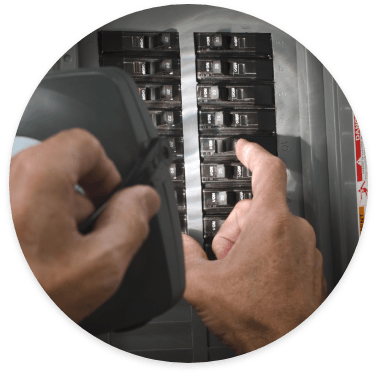If your current breaker panel isn’t cutting it for your home, then it’s time to install a new one. You’ll know this is the case if your current panel isn’t delivering all the power your home needs. Instead, you’re short on outlets, your phone charges slowly, and the lights always seem dim.
Even if you have enough power, you’ll also want to switch out the breaker panel if yours is no longer in good shape. For example, it might be making buzzing sounds, giving off unpleasant smells, or showing rust damage. When you’re ready for a new service panel, you’ll want to make sure that you install the one that’s right for your home. To do that, pay attention to the type of panel and the size.
Types of Breaker Panels
Not all breaker panels are the same. Before you replace yours — or install a new panel somewhere in the home — think about the type you need.
Main Electrical Panels
Right now, you may have a fuse box. This is an older system that relies on fuses. When one fuse blows, it must be replaced. If you currently have a fuse box, replacing it with another is not your best bet. Rather, you’ll do well to put in a main breaker panel instead.
A main breaker panel is also called the main electrical panel. This rectangular box serves as the electrical control system for your home. The wires from the outside power supply run into it, and the wires that deliver electricity throughout your home run out of it. The main breaker panel contains the main breaker for your home. When you flip that breaker off, you’ll cut the electrical power to the entire house. Plus, the panel contains switches for the individual circuits that support different appliances or areas of your house.
In general, every home needs a main breaker panel. And if you’re replacing your main panel, you need to choose another one in its place.
Additional Panels
In some houses, the main breaker box is not the only one. If you have an additional type of panel, then you’ll need to replace it with a box that’s suitable for that purpose.
Subpanels are typically smaller than the home’s main breaker panel. Also called satellite panels, they are useful for situations in which you have an area outside of the house that requires power. For example, your garage may have its own subpanel. You might have a backyard subpanel to power your hot tub or your swimming pool. Subpanels aren’t standalone units; they are wired to your main breaker panel. However, each subpanel has its own main breaker that will cut off the power to anything connected to its circuits.
Lug panels are a different type of breaker box. They can be used in place of the main breaker panel or a subpanel. The distinction is that lug panels don’t contain a main breaker. That’s located elsewhere, typically at the meter. Some homes also have a transfer switch. That’s a type of panel that connects to a generator. In situations where you need to use your generator, the electricity that it produces will run through the transfer switch instead of the regular panel.
Breaker Box Sizes
In addition to selecting the right type of breaker box for your project, you must also pay attention to sizing. That means selecting a unit that can handle sufficient amperage and contain enough circuit breakers for your needs.
There are several different sizes available for your home breaker box:
- 100 amps
- 125 amps
- 150 amps
- 200 amps
- 400 amps
To figure out which is correct for you, calculate the wattage required by the lights, appliances and other electric items in your home. For example, your clothes dryer will need its own 30-amp double-pole circuit breaker, which will contribute 6,600 watts to the total wattage. You must also consider the washing machine, dishwasher, furnace, air conditioner and other major appliances. Your electrician can help you with these calculations.
Once you determine the total wattage, divide it by 230 to figure out the required amperage for your breaker panel. Round the number up to the nearest available box size. Many homes today can benefit from 150-amp systems or higher because they allow room for adding more appliances and can contribute to your home’s value.
You’ll also need to make sure that you select a box that has enough spots for the number and types of circuit breakers that you need. As you spend time adding up your total home wattage requirements, it will probably become clear how many circuits are required. If you select a main breaker box that’s properly suited to the number of amps required by your home, then there’s a good chance it will have spots for enough switches. Once again, you can consult your electrician for guidance.
Breaker Panels and Local Codes
In addition to considering type and size, you must also pay attention to local building codes when putting in a new breaker box. You’ll want to make sure that you purchase a unit that complies with these codes.
Your municipality may have rules about what room can house the service panel and how much clearance it must have. There may also be guidelines about the door — for example, it must open at least 90 degrees. In addition, there might be regulations about how many circuits you need to have and how you should label them. Breaker panels placed outside may require special weatherproofing measures.
To learn more about the requirements for service panels in your area, reach out to your city and your electric company. A qualified local electrician should also be familiar with the rules in your area.
Installing a Breaker Panel
Putting in your new breaker panel shouldn’t be a do-it-yourself job. Rather, it’s a project to entrust to the pros. An experienced electrician will know how to do the job safely and correctly. Remember, there’s no need for you to make breaker panel decisions all on your own. Your trusted Richland Hills electrician can also guide you to the right size of unit for your property. Furthermore, your electrician may take care of providing all the supplies for your project, including the breaker panel itself.
Keep in mind that this is a matter of safety. If you don’t know what you’re doing, you could get hurt during the installation process. Plus, an improperly sized and installed breaker panel can be a fire hazard. Choosing professional installation reduces the risk of a catastrophic event. You’ll protect your home and your family by choosing the guidance of a professional electrician.
HR Phoenix provides electrical services for commercial and residential properties in Richland Hills and the surrounding area. In addition to electrical panels, our electricians also work with generators and electric vehicle charging stations. You can count on us when your electrical systems require repairs or your property needs to be rewired. Plus, we have plumbers who can take care of projects like water heater installations and pipe replacements. Our family-owned business offers free estimates and 24-hour emergency repair services.
For your next electrical or plumbing project, please give HR Phoenix in Richland Hills a call!


